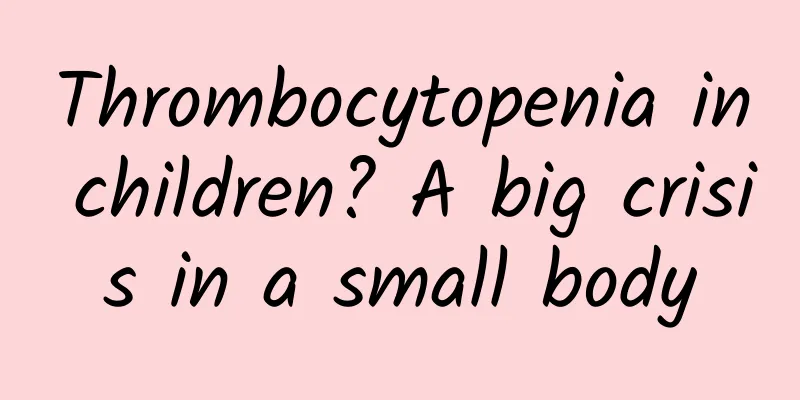Thrombocytopenia in children? A big crisis in a small body

|
Author: Li Shanshan, attending physician at the Children's Hospital affiliated to Shanghai Jiao Tong University School of Medicine Reviewer: Shao Jingbo, Chief Physician, Children's Hospital Affiliated to Shanghai Jiao Tong University School of Medicine In the outpatient department of hematology, mothers often bring their children to the clinic in a very nervous and anxious manner. They often suddenly find bleeding spots, bruises, or ecchymoses on their children's skin or oral mucosa. Some children suddenly have nosebleeds. Some children are asked to see the hematology department because of abnormal blood routine tests during treatment of other diseases. In addition to the above bleeding symptoms, most children do not have other blood system problems such as anemia and severe infection, but they are often accompanied by a significant decrease in platelet count. If the peripheral blood routine test indicates that the platelet count is less than 100×109/L, it is thrombocytopenia, which is the most common bleeding disease in children[1]. After the doctor inquires about the medical history in detail, he will find that most children have a history of infection such as fever, cough, diarrhea, or have been vaccinated in the past two weeks. Most of them have no family history of similar bleeding or other blood system diseases; physical examinations do not show enlarged liver, spleen, or lymph nodes; except for the decrease in platelet count, most other indicators of the blood routine test are normal. In this case, the first thing to consider is primary immune thrombocytopenia. Figure 1 Copyright image, no permission to reprint 1. What is primary immune thrombocytopenia? Immune thrombocytopenia (ITP), formerly known as idiopathic thrombocytopenic purpura, is a common bleeding disease characterized by isolated thrombocytopenia in childhood. The incidence rate among children in my country is (1.6-5.3)/100,000 [1]. The pathogenesis of ITP has not yet been fully elucidated. Studies have shown that immune abnormalities are the core pathogenesis of ITP, which can often be traced back to a history of previous infection or vaccination in children. 2. Clinical manifestations of primary immune thrombocytopenia Typical manifestations of primary immune thrombocytopenia include: clinical manifestations with only bleeding symptoms; physical examination shows only skin and mucous membrane bleeding; laboratory tests show only thrombocytopenia in at least 2 blood routine tests, with or without clearly diagnosed iron deficiency anemia or hemorrhagic anemia, no abnormal white blood cells or peripheral blood smear; no family history of bleeding diseases. 3. Identification and risks of primary immune thrombocytopenia Before confirming primary immune thrombocytopenia, the diseases that need to be ruled out first are divided into decreased platelet production (including hereditary bone marrow failure syndrome, hereditary thrombocytopenia, aplastic anemia, blood system malignancies, malignant tumors bone marrow invasion, infection, nutritional hematopoietic raw material deficiency, and autoimmune diseases in which antibodies attack bone marrow hematopoietic cells), increased platelet destruction (including hereditary immune thrombocytopenia represented by eczematous thrombocytopenia with immunodeficiency syndrome, hereditary non-immune thrombocytopenia represented by hereditary thrombotic thrombocytopenic purpura, autoimmune diseases in which antibodies attack platelets, Evan syndrome, drug-induced, hemangioma with Kahn-Metz syndrome), and abnormal platelet distribution (hypersplenism). If the doctor feels that these diseases cannot be ruled out, corresponding examinations are needed for further diagnosis. The main risk of thrombocytopenia is bleeding. Most children present with post-collision or spontaneous skin purpura or bruises, nasal mucosal bleeding, and in a few cases, the platelet count is less than 10×109/L, with the possibility of visceral bleeding, intracranial bleeding, and even life-threatening conditions. Bleeding in patients with thrombocytopenia is graded as follows: Grade 0 means no bleeding; Grade 1 means mild or trace bleeding, i.e., a small number of petechiae (total number ≤ 100) and/or ≤5 small ecchymoses (diameter ≤ 3 cm), without mucosal bleeding; Grade 2 means mild or small bleeding, i.e., a large number of petechiae (total number > 100) and/or >5 large ecchymoses (diameter > 3 cm), without mucosal bleeding; Grade 3 means moderate or moderate bleeding, i.e., obvious mucosal bleeding that affects life; Grade 4 means severe or serious bleeding, i.e., mucosal bleeding causes a decrease in peripheral blood hemoglobin of > 20 g/L, or suspected visceral bleeding [1]. IV. Treatment of primary immune thrombocytopenia It is recommended that parents take their children to seek medical treatment actively and let the children receive reasonable treatment in time. The revised guidelines for the diagnosis and treatment of primary immune thrombocytopenia in Chinese children (2021 edition) recommend: The platelet count of children is used as a secondary basis for treatment decisions, while the degree of bleeding and whether life is interfered with by the disease are used as the primary basis. When the bleeding symptoms of newly diagnosed children (course of disease <3 months) are limited to grades 0~2 and their lives are not interfered with by the disease, close observation and follow-up are recommended. At the same time, protection should be strengthened to avoid trauma and infection to reduce the risk of bleeding; regularly review the platelet count and change trend of children, and timely assess the risk of bleeding. If the platelet count is lower than 20×109/L, the risk of bleeding is considered to be increased, and it is recommended to start treatment. The conventional first-line treatment is a short course of glucocorticoid therapy. When the bleeding is more severe (grade 3-4), hospitalization is recommended, and intravenous infusion of immunoglobulin is preferred for emergency treatment. For children with persistent (course of 3-12 months) and chronic (course of >12 months) primary immune thrombocytopenia, appropriate treatment options can be selected under the guidance of a hematologist according to their bleeding conditions and whether their lives are disturbed by the disease, such as observation and follow-up, conventional treatment, emergency treatment, and even rescue treatment to reduce bleeding symptoms. If the above first-line treatment is ineffective, platelet-stimulating drugs are preferred as conventional second-line treatment options. Other second-line treatment options include the use of rituximab and splenectomy. In addition, it is recommended that children avoid vaccination during follow-up observation or treatment. Figure 2 Copyright image, no permission to reprint Primary immune thrombocytopenia in children is a self-limiting disease. International multicenter data suggest that [2-4] the spontaneous remission rate of primary immune thrombocytopenia in children is high. When the course of the disease does not exceed 1 year, the spontaneous remission rate is 74% for children under 1 year old, 67% for children 1-6 years old, and 62% for children 10-20 years old. The proportion of children with chronic primary immune thrombocytopenia who have not spontaneously remitted for more than 1 year is 5%-10%. Chronic primary immune thrombocytopenia still has a chance to be remitted with active and reasonable treatment and follow-up management. References [1] Chinese Journal of Pediatrics, 2021. Diagnosis and Treatment Guidelines for Primary Immune Thrombocytopenia in Children: Revision Working Group, Chinese Society of Pediatrics, Hematology Group, Chinese Journal of Pediatrics Editorial Board. Chinese Journal of Pediatrics, 2021, 59(10):810-819. [2] Wu Runhui, Liu Yali, Gao Ju, et al. Interpretation of the revised guidelines for the diagnosis and treatment of primary immune thrombocytopenia in children in China (2021 edition)[J]. Chinese Journal of Pediatrics, 2021, 59(10): 820-823. [3] Bennett CM, Neunert C, Grace RF, et al. Predictors of remission in children with newly diagnosed immune thrombocytopenia: Data from the Intercontinental Cooperative ITP Study Group Registry II participants [J]. Pediatr Blood Cancer, 2018, 65(1). [4] Imbach P, Kühne T, Müller D, et al. Childhood ITP: 12 months followup data from the prospective registry I of the Intercontinental Childhood ITP Study Group (ICIS)[J]. Pediatr Blood Cancer, 2006,46(3):351-356. |
>>: Anesthesia: The invisible force that protects life safety
Recommend
World Osteoporosis Day | What does poor kidney function have to do with osteoporosis?
October 20th is World Osteoporosis Day. With the ...
Where is the Yunnan-Guizhou Plateau located? What is the largest lake on the Yunnan-Guizhou Plateau?
The Yunnan-Guizhou Plateau is located in southwes...
How is sago made? Can sago be left overnight after cooking?
Friends who often drink milk tea know that there ...
Is it useful to use a belly support belt if the placenta is low?
Of course, the placenta should pay attention to t...
How much does it cost to do a 3D B-ultrasound?
In order to give birth to a baby healthily and co...
How to make hawthorn jelly? How to make hawthorn chrysanthemum tea?
Hawthorn fruit can be eaten raw or made into pres...
Why can't girls hold their urine?
Some girls often have difficulty holding their ur...
Sore arms and legs during early pregnancy
In the early stages of pregnancy, women are very ...
How low can Epiphyllum withstand? How to maintain Epiphyllum in low temperature?
Epiphyllum is a common flower in life. It is love...
Why does it take an average of 8 years to diagnose this disease with an extremely high suicide rate?
【Written at the end】 42.3 % of bipolar disorder c...
Leucorrhea is watery_Leucorrhea is watery_Leucorrhea is watery
Watery leucorrhea is mainly caused by gynecologic...
Can I drink coffee before my period?
We do not recommend female friends to drink coffe...
What to do if you have vaginal bleeding after sex
It is normal to bleed after your first sexual int...
What causes dark red menstruation?
Many female friends usually do not pay much atten...
A woman with a red mole on her palm
It is a common phenomenon to have moles on the bo...









